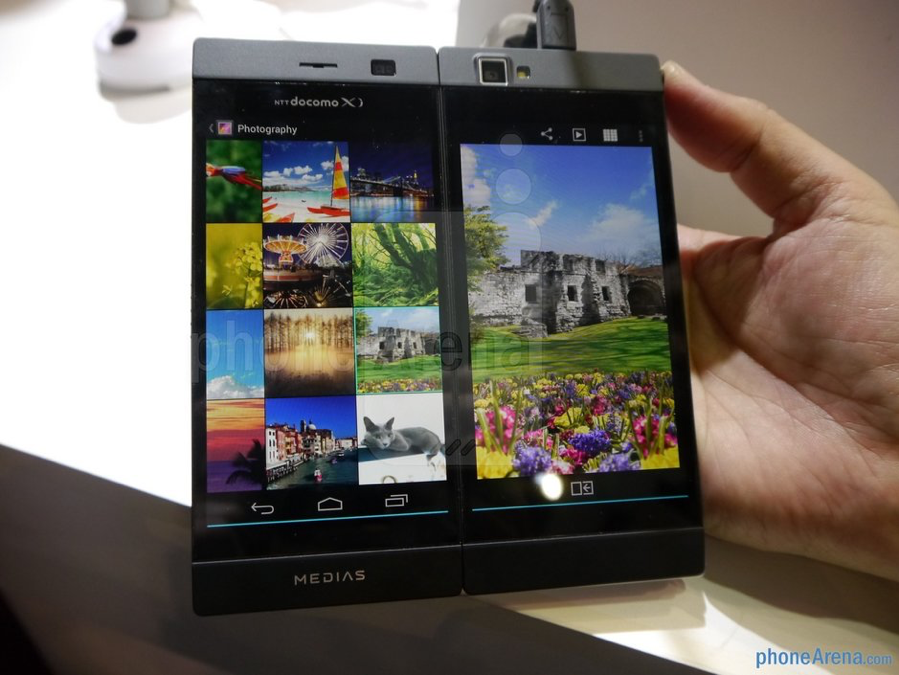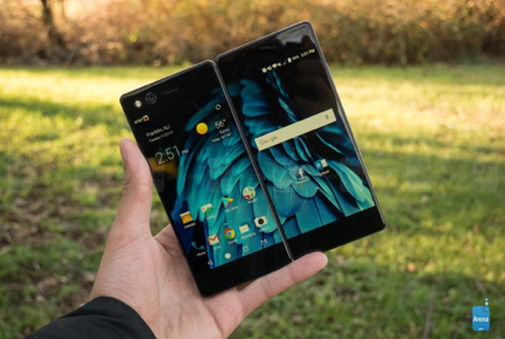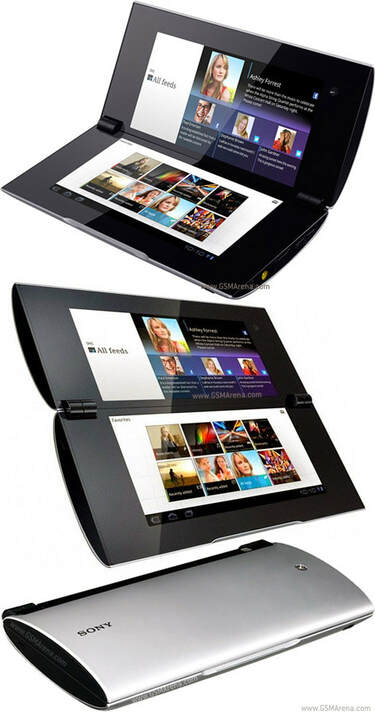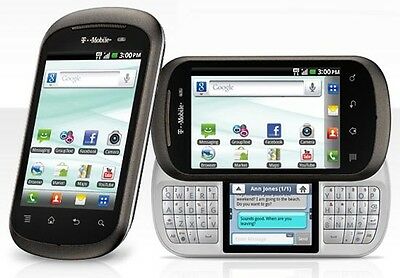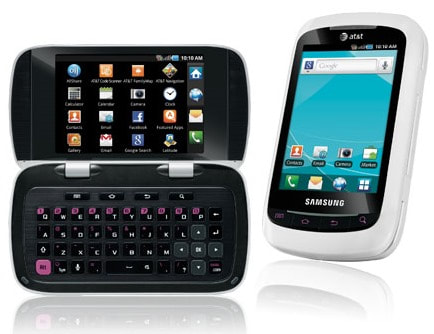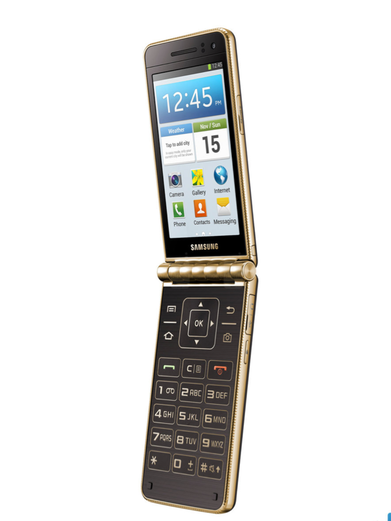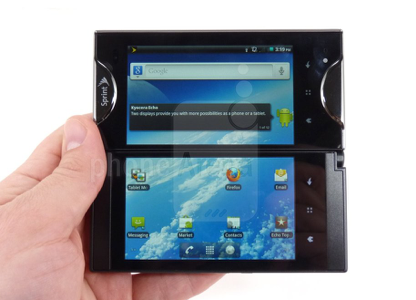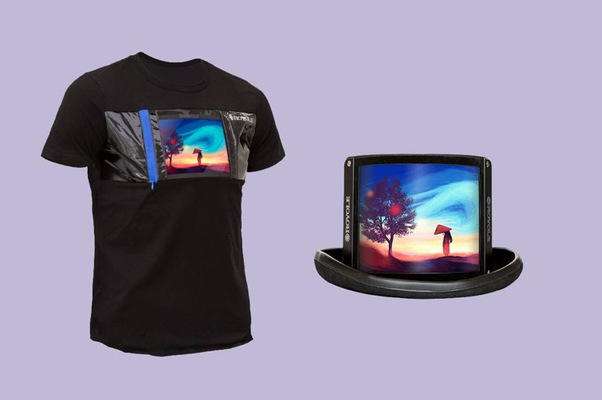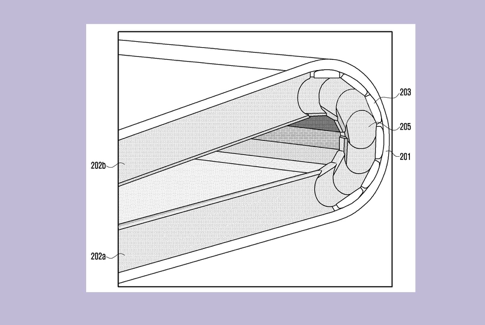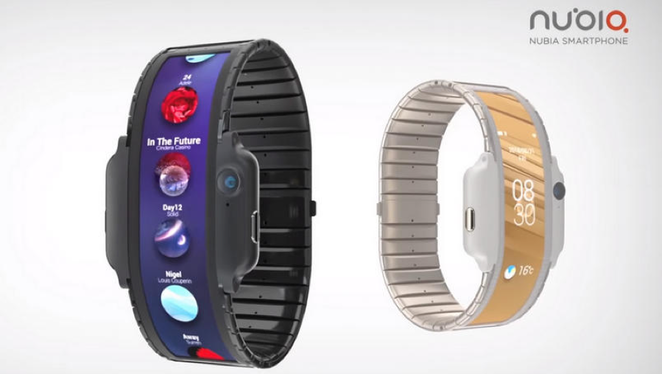Vertical Divider
|
Special Report on Foldable/Rollable Display
February 04, 2019 Royole’s foldable phones are already available in China and LG, Motorola, OPPO, vivo Lenovo and Xiaomi have foldable handsets in development, while Samsung’s foldable smartphone will be announced at MWC, this month. But a bit of doubt about their potential to become mainstream remains. Several mobile devices attempting to popularize a foldable design have teased before consumers, but there has yet to be one achieving widespread acceptance. Figure 1:NEC Medias W Source: phonearena
|
|
Arguably the most obscure of the bunch was the NEC Medias W that never saw the light of day outside of Japan. Featuring dual 4.3-inch qHD displays, which utilized a hinge to fold over the two displays side-by-side to one another. Not only did it offer the convenience of extra real estate to surf the web, but also allowed users to interact with the app on one display – while the other can be used as a keyboard. Released in 2013, the NEC Medias W wasn’t a shabby job for a foldable phone, but it was thick when closed because it was two smartphones rolled into one, but it offered just about the same utility that any other smartphone offered at the time. The main problem, however, was that the interface wasn’t optimized to take advantage of the dual displays. This isn’t just isolated to the NEC Medias W, but it was and has continued to be a challenge for manufacturers going for the foldable phone.
Figure 2:ZTE Axon M
Figure 2:ZTE Axon M
Source: Company
In late 2017, the ZTE Axon M was an evolution to the foldable smartphone design. The design wasn’t too far away from the NEC Medias W, since it also employed dual displays held together by a hinge – allowing them to come together side-by-side with an even skinnier bezel in between the two displays. Unlike NEC’s offering, the ZTE Axon M benefitted from Android’s advancements that enabled side-by-side apps multitasking. Many apps were optimized to run simultaneously, so the two displays allowed for dedicated apps to run on them. However, it failed to deliver a practical experience for a smartphone that transforms into a mini tablet of sorts.
Figure 3:Sony Tablet P
Source: gsmareana
In 2012, Sony delivered what some paint as one of its quirkiest devices ever to be released – the Sony Tablet P. At first glance, it seemed like they produced a clutch bag or something because of its shape and size, but it was in fact a foldable tablet that featured two 5.5-inch 1024 x 480 LCD panels. It was an ambitious offering by providing an optimized layout with many native apps. Even better, the Sony Tablet P was PlayStation certified, which allowed you to playsome old PlayStation games. The top display showed all the action, while the bottom one featured the on-screen controls – giving users an unobtrusive view of the game. However, the Tablet P was quickly forgotten because it was notoriously choppy with its performance, it shot terrible looking photos and videos, and the battery life was atrocious.
LG DoublePlay was a disaster of a smartphone in 2011. It relegated the secondary display to multi-tasking duties for a limited selection of native apps. And on top of that, the secondary display effectively split the landscape keyboard in half, thus reducing its effectiveness compared to a standard landscape QWERTY.
LG DoublePlay was a disaster of a smartphone in 2011. It relegated the secondary display to multi-tasking duties for a limited selection of native apps. And on top of that, the secondary display effectively split the landscape keyboard in half, thus reducing its effectiveness compared to a standard landscape QWERTY.
Figure 4:LG DoublePlay
Source: PicClick
Rivaling the LG DoublePlay was the Samsung DoubleTime with a clamshell design featuring two 3.2-inch touchscreen displays, one on the outside and one that opened up alongside the QWERTY keyboard. Unfortunately, the displays were washed out, the phone was generally sluggish, and its battery life was on the weak side and was soon forgotten.
Figure 5:Samsung DoubleTime
Source: Gadgetian
Figure 6:Samsung Galaxy Golden
Source: phoneArena
The Samsung Galaxy Golden was also one of those phones that never saw the light of day outside its home market. Fashioned with nostalgia in mind with its flip phone-esque design, the Samsung Galaxy Golden came with dual 3.75-inch AMOLED displays, a Snapdragon 400 processor, 2GB of RAM, and two cameras. A traditional dial pad and physical buttons accompanied all of that.
Figure 7:Acer ICONIA 6120
Source: Company
The 2011 Acer ICONIA 6120 was a dual-screen tablet/PC, essentially a prelude to the Microsoft Surface with all the bells and whistles of any ordinary laptop at the time. It ran Windows 7 Home Premium a while before Microsoft fully committed to a touch-optimized interface, which is partly to blame for its troubles. It was a traditional Windows desktop experience with some touch elements thrown in for the novelty. The extra secondary screen acted as the on-screen keyboard. The Acer ICONIA 6120 was just a bit too ahead of its time, but this dual-screen laptop wasn’t convincing about its advantages as a foldable mobile device.
Figure 8:Kyocera Echo
Figure 8:Kyocera Echo
Source: phoneArena
The 2011 Kyocera Echo put the mechanism to position the dual 3.5-inch LCD screens next to one another, and the spring hinge didn’t give users the confidence that it would stay firmly in place. Secondly, the amount of lag due to the phone having to work harder with the dual displays made it almost unusable. Third, the battery life was severely affected because of the extra screen in play. The biggest letdown about the Kyocera Echo was that it lacked the necessary refined experience. It did offer some level of side-by-side multitasking, but it still felt more like an extended smartphone experience and it didn’t feel like a tablet. The device also looked and felt cheap
The short history of these devices shows the difficulty of building a foldable device without a foldable display or a multi-window UI. Now, this technology exists and is on the cusp of becoming a Very Big Deal in the tech industry, in marketing and research terms. Manufacturers think flexible is a fantastic idea, but the pressing question is how much real-world appeal the hardware really has.
Figure 9:Royole’ Embedded Flexible Displays
The short history of these devices shows the difficulty of building a foldable device without a foldable display or a multi-window UI. Now, this technology exists and is on the cusp of becoming a Very Big Deal in the tech industry, in marketing and research terms. Manufacturers think flexible is a fantastic idea, but the pressing question is how much real-world appeal the hardware really has.
- Matthew Cockerill, creative director and head of studio London at Swift Creatives, says that, beyond the obvious benefit of putting bigger smartphones in our pockets, "with a nascent technology there are always more questions than answers. This technology is an innovation trigger for brands and designers who have to work out what the value of these products are for users." The real challenge, he says, is to make folding tech viable once it's no longer a novelty: "In a plateauing smartphone market, it certainly offers an opportunity to reinvigorate the category."
- Luke Miles, co-founder and creative director at New Territory, says that, "in terms of our living spaces, there is an opportunity to create a whole new category of objects that are more empathic to these environments. TV’s have always been thought of as traditional, black boxes that hang from the wall or sit on a stand, but folding screens would allow us to develop them, so they blend more elegantly into an interior. "Even if the first generation of TVs, like LG's 65in Signature OLED TV R, just roll away neatly into their bases, it's a look that'll appeal to fans of minimalist or unobtrusive decor, as well as meaning that there'll be fewer concerns about accidentally knocking over a large and fragile screen when it's not in use.
Figure 9:Royole’ Embedded Flexible Displays
Source: Royole
And it's not just big or complex items. Innolux has made a round 1.39-inch 400x400 (287 PPI) panelsince 2017 while the Cleer Mirage Smart Display Speakeraccompanies your music with information and visuals on a wrap-around
A key question about folding phones is how much wear and tear they'll take before either hinges or screens give out - it's a been a critical focus of research into folding displays. Royole saysthat its FlexPai can be folded 200,000 times. Swift Creatives' Matthew Cockerill also highlights manufacturing and design tolerances as a key concern: "A major limitation is the bend radius with these first-generation screens that dictate the overall form of the phone and the mechanical strain relief required to protect the fold in daily use. This will influence the hinge area of our once rigid smartphone." The Korea Herald, reported an executive from a Samsung customer firm said: "When unfolded, Samsung’s foldable phone does not show any crease indicating it had been bent. However, completely folding the device will lead to a breakage. For this reason, Samsung is testing out the device so that the sides remain slightly lifted when folded.”
Figure 10:Foldable Display Hinge
- Royole has embedded flexible displays in hats and t-shirts. Although TVs and phones are the glamorous headline items when it comes to flexible displays, there are plenty of other applications for the technology.
- Luke Miles says that folding screens mean we could create more ergonomic and responsive wearables: "the strap and technology would no longer need to be separated as they are today. They could essentially become flexible, living surfaces that contract and expand in tandem with your body, allowing you to move more freely. This would also have positive implications for the way in which data is collected via these devices." There's also huge potential for flexible displays in the automotive sector, he adds: "Screens and information that can seamlessly transition from in front of the driver or passenger to either side of them. This will be particularly useful when autonomous vehicles begin to play a larger role in society. Passengers will begin to spend their time differently when travelling, so new types of interaction and information will need to be delivered."
- Craig Bunyan, lead creative technologist at Seymourpowell, says that there's a durability argument for flexible display tech, too: "It might be less seductive than rolling up your laptop and putting it in your pocket, but the last few generations of large-form-factor smartphones have been plagued with bending problems. At its most basic, flexible screen technology could mean that we can actually sit on a 6in smartphone and not break it." In the case of potential fully flexible devices of the future, such as the next evolution of wearable tech, manufacturers will have to consider the positioning, construction and materials of other components. However, flexible graphene batterytech is also in development. Ultimately, Bunyan says, it's not just screens that'll have to flex: "Any device which is to take full advantage of a folding screen must also make it possible to bend and flex the associated electronics behind that screen."
And it's not just big or complex items. Innolux has made a round 1.39-inch 400x400 (287 PPI) panelsince 2017 while the Cleer Mirage Smart Display Speakeraccompanies your music with information and visuals on a wrap-around
A key question about folding phones is how much wear and tear they'll take before either hinges or screens give out - it's a been a critical focus of research into folding displays. Royole saysthat its FlexPai can be folded 200,000 times. Swift Creatives' Matthew Cockerill also highlights manufacturing and design tolerances as a key concern: "A major limitation is the bend radius with these first-generation screens that dictate the overall form of the phone and the mechanical strain relief required to protect the fold in daily use. This will influence the hinge area of our once rigid smartphone." The Korea Herald, reported an executive from a Samsung customer firm said: "When unfolded, Samsung’s foldable phone does not show any crease indicating it had been bent. However, completely folding the device will lead to a breakage. For this reason, Samsung is testing out the device so that the sides remain slightly lifted when folded.”
Figure 10:Foldable Display Hinge
Source: USPO
For the forthcoming generation of flexible TV screens, the mechanisms are more forgiving, as rollable screenssuch as LG's 65in Signature OLED TV Rdon't have to endure the intense flexing of folding devices. Google announcedscreen continuity and multi-resume support for Android at the November 7 Android Dev Summit 2018, meaning that the mobile OS now has native support for folding screens in various configurations. Royole, which got in early with its FlexPai missed out on Google's secretly developed support for folding screens in Android, instead implementing its own Water OS user interface on top of an earlier version of the OS. However, the company will be investing $30 million to fuel the creation of apps for its platform. Samsung has also published guidanceand an emulator for developers working on apps for flexible displays. So far, there haven't been many solid app announcements, but native Android apps such as Google Maps have been shown in example images of flexible screens, and news app Flipboardhas saidthat it will support the forthcoming flexible Galaxy's folding capabilities. An anonymous Korea Heraldsource says Samsung plans to produce a small run of 1 million folding Galaxy devices, anticipated to launch in the first half of 2019. Their target audience, "Men in their 40s" who remember the glory days of folding feature phones and who have enough money to afford the anticipated 1.5+million won price. The following summarizes current activity:
Yet another contender in the battle of form factors is the nu.oio., Nubia’s wearable smartphone, expected to be announced at MWC.
Figure 11:Nubia’s The Πu.oio.
- Samsung:Samsung's Infinity Flexoriginates with its displays division, based on flexible AMOLED technology first demonstrated in 2011. Its 7.3in foldable display with a 1,532x2,152 resolution at 360PPI (pixels per inch) is what we'll be seeing in future folding smartphones. Samsung is the most serious contender when it comes to having the ability to mass manufacture folding phone screens right now.
- Royole:Display-making startup Royole launched its FlexPai with a 7.8in 1,920x1,440 (308PPI) AMOLED display, effectively demonstrating its folding screen tech, but also makes the Flexible+display range for wearables.
- LG:LG's rollable TV screensare well on the way to becoming a commercial reality, and it's also reportedto be working with Apple, Google and Microsoft to develop a folding smartphone screen by 2020,
- BOE:currently developing some impressive high-resolutionfoldable screens. Its device manufacturing partners reportedlyinclude Huawei, along with two other unnamed device makers.
- Visionox:a major player in the Chinese foldable market, partneringwith smartphone maker Nubia to create the Alpha. The Alpha, a long, slim foldable device that transforms from a skinny phone into a wrap-around smartwatch, appears to have missed its projected 2018 shipping date.
- Xiaomi:When it comes to better-known device makers, Xiaomi is only at the prototype stage, as demonstratedin a Weibo video by company president and co-founder Lin Bin, who says the firm will consider mass production if it gets positive feedback. We don't know where Xiaomi is sourcing its displays, however
- Lenovo:Lenovo-owned Motorola, meanwhile, is reportedlyplanning to bring back its iconic Razr flip phone as a high-end folding Android device. Lenovo has demonstrated a number of foldable phone prototypesover the years, but the flexible display-manufacturing partner is still unknown.
- Microsoft:The Android project purports to include a foldable device that can serve as a phone and a Notebook
- Huawei: Confirmed at a pre-MWC 2019 briefing in Beijing that it will unveil a high-end foldable 5G smartphone at the mobile show. Richard Yu, the CEO of the Chinese company's Consumer Business Group, didn't mention the name of the device or reveal details about how it would fold he did say that the upcoming foldable phone will use a new 5G modem, the Balong 5000 that is integrated into Huawei's next-generation flagship mobile chipset, the Kirin 990—the successor of Huawei's current top-of-the-line processor, the Kirin 980, which powers the phone maker's flagship smartphone, the Mate 20 Pro.
- Dell:Working on a 2-in-1 device (notebook and tablet) that uses a flexible OLED display with a hinge built around “five geared rotational hinge elements” that facilitate the folding action. Dell engineers say: “In order to support OLED film display during folding, the OLED film is coupled to two display frame structures coupled together with a flexible support between display frames at the location of the fold of OLED film display.”
Yet another contender in the battle of form factors is the nu.oio., Nubia’s wearable smartphone, expected to be announced at MWC.
Figure 11:Nubia’s The Πu.oio.
Source: Company
Nubia, which started off as a subsidiary of ZTE, will be launching a flexible device that won’t be ‘foldable’. Instead, it’ll come with a ‘flexible’ screen and fall under the wearable category, which classifies it as a smartwatch. If my experience with Apple’s Watch 4 is any indication and the Nubia comes with a larger display and more features, it could be competitive with smartphones in general.
|
Contact Us
|
Barry Young
|

